24 Types of Chisels to Have on Hand & Fill Out Your Collection
Author: Omar Alonso | Editor: Omar Alonso
Review & Research: Jen Worst & Chris Miller

There are different types of chisels for every job and identifying which one suits your project, is just about a little planning. The best way to do that is to buy a beginner’s set because they are an affordable tool.
This also keeps you prepared for any scenario. But even then, you get it right only if you know what each of them does.
24 Types of Chisels
Egyptians used copper and bronze chisels to shape soft stone and wood, and even before that there were flint chisels dating as far back as 8,000 BC. The chisel is an ancient tool that has only improved with time. Here is a primer on what all of the chisels types out there are used for. Half the battle of doing good work is knowing what tools are available, so make sure you check them all out.
Bevel Edge Chisel
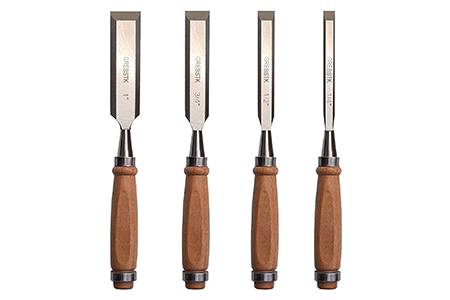
This one is a medium-sized chisel. It is quite common and very useful in a cabinet shop, especially if you are a woodworker. When you pick a beveled edged bench chisel, you must make sure that it is comfortable in your hand.
The edge must be good and easy to sharpen so that you do not have to keep running to the hardware store. How do you know that? By checking the back of the chisel. It must be flat or slightly hollow.
These chisels are bevels on both sides so that you can access the dovetails well. When you get a set of chisels, this one is a must have.
Some of them have a hooped handle so that they are strong enough when you use them with a hammer to strike an object. But if your chisel does not have the extra hooping it is probably because the manufacturer wanted it to have a lower balance point.
A beveled edge bench chisel is quite straightforward to work with because you do not need prior experience to use it and the chisel does not need to be overly sophisticated to do the job.
These chisels come in many sizes and can be used for a wide range of tasks. The beveled edges on the side are kind of a trademark and the blades are usually moderately thick so that they can withstand a good amount of wear and tear.
If you do not want to buy a set but just one chisel, go for the beveled edge bench chisel. You will not regret it.
Heavy Duty Bevel Edge Chisel
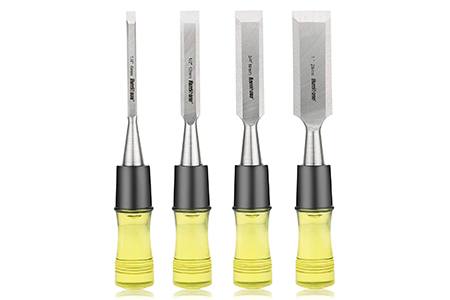
This one is not used as much in making furniture as it is in building boats and a little bit in timber framing or doing stuff where details don't matter like shaving shims from whatever types of plywood you may be using.
But generally speaking, these chisels are used whenever you are dealing with big and complicated wooden parts. As you can imagine, they are not highly in demand. The heavy-duty beveled edge chisel is extremely durable and suited to bit projects with a little grit.
And since not many people are into building boats, these chisels are not often spotted in the market and otherwise. But this one is a product meant to stay sharp, last a long time and feel good in your hands.
Corner Chisel
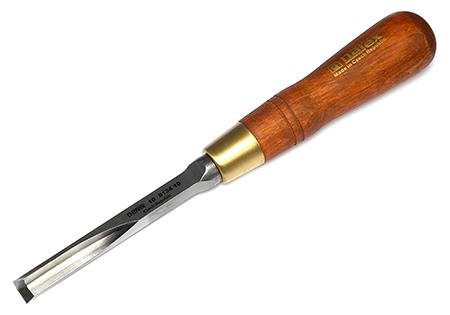
Corner types of chisels have an average, medium-length handle and blade, culminating in a v-shaped cutting section on the end. The v-shape is obviously meant to refine 90 degree corners, especially for cabinetry.
No matter what kind of wood you're using, if you're creating squared corners, you'll want one of these. You'll also want oil stones in order to sharpen both edges separately, since we're talking about precision work here.
Socket Chisel
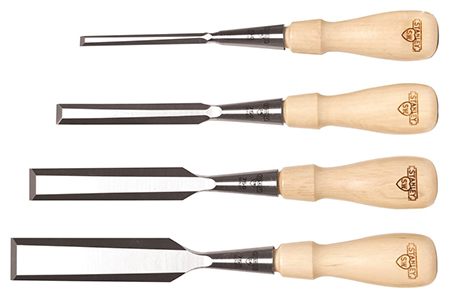
A socket chisel gets its name from the fact that the handle is big and bulbous at one end and has a socket on the other that receives a round piece of metal extruding from the back end of the blade.
These large, usually wooden, ends are designed to be hit with a rubber mallet in such a way that they won't crack or break due to the beatings and pressure applied.
They're not meant for refined details but heavy-duty work that gets you closer to where you need to be.
Japanese Chisel
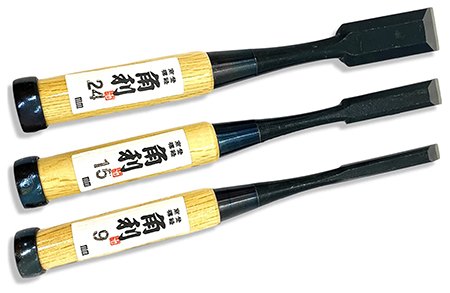
These are not so much different from the western bench chisels in terms of size. These are also extremely high-quality chisels that are hooped and have hollow ground back.
But they have laminated steel construction and are slightly thicker. The big difference though is that they have less bevelling on the sides, especially the narrower models because they come from a farming tradition.
They also have thicker blades and sharper edges. The edges are also harder than their western counterparts which makes them a great choice for lab tests.
And they do well in those tests. These chisels are excellent tools to cut softwoods and remove the edges without crumbling. They are also prone to resist the abrasions of tropical woods.
If you are looking for a chisel to do some casual woodwork, the differences hardly matter.
Framing Chisel
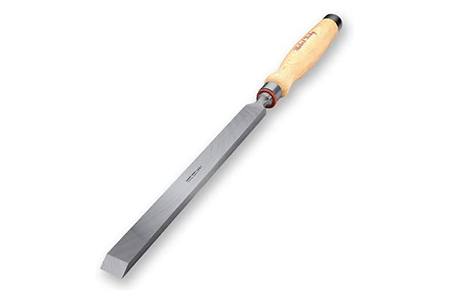
Framing chisels are used in tasks such as beam and post creation, building boats, and framing timber. Like socket chisels they come with a bulbous end, sometimes reinforced with metal, because they're meant to be pounded on by most types of hammers or mallets.
In order to help the chisel stand up to the repeated hits from a mallet, the handles will be reinforced with metal loops to help stop the wood from splitting, sockets to keep it attached to the blade, and even metal capped ends
Bench Chisel
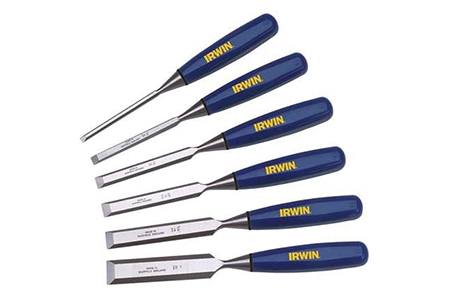
A bench chisel is typically shorter than others, and are meant for precision work when you need to really focus on the details, like with cabinet and furniture making. You can, of course, use it in tasks like paring, trimming, joining, and chopping, but for detail oriented work you can't beat it.
They're usually around 10 inches long, with a 5-inch handle culminating in a 5 inch blade. A portion of the blade will be recessed into the socket of the handle and will feature a capped end to support it from the mallet beating it will take.
Bolster Chisel
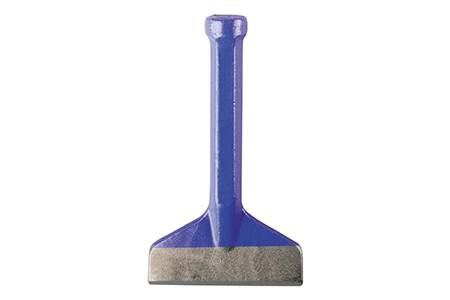
Bolster types of chisels are sometimes known as a brick chisels. It's used to score straight lines into bricks and masonry. They're sharp and durable enough to withstand those materials due to the material it itself is constructed from.
You should avoid using them with wood or metal because it can cause the end to be dulled, in which case you'll be back to sharpening it very soon.
Cape Chisel
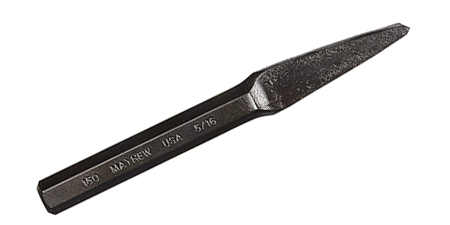
Cape chisels are very much like cold chisels. They're shaped more like arrowheads, tapering down towards the front. Take note of the metal it's made from, because they're designed to cut on metals softer than itself. Otherwise you'll damage or break them.
You can use them to cut grooves into metal, score out keyways, or even create fine patterns on metal surfaces.
Mortise Chisel
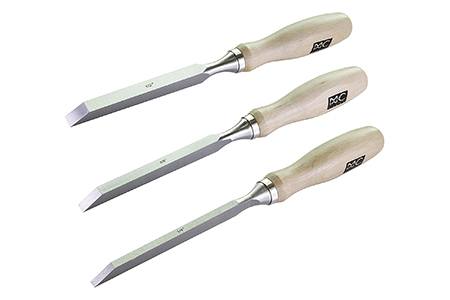
When mortising, a chisel is usually malleted into the wood and levered out so that the waste can be removed. Now, you cannot use a bench chisel for that because it does not do well with the levering out due to its thickness.
You also cannot use a stout blade because it also cannot tolerate the abuse from the hammer and does not have the required length. In fact, all the malleting actually chips the blade and mushrooms the handle which destroys the chisel.
For that reason, a special chisel was developed. The original English mortise chisels had almost gone out of style but some manufacturers are still in the game.
These chisels are heavier and thicker than the regular ones. They are wide and have huge forged bolsters and beech or oak handles that give them the tolerance required for the task.
They are really easy to handle and it is quite fun to use them. Mortise chisels are available in ⅛ to ½ by 1/16 inches in size. If you want to get just one of these, go for the ¼ inches or ⅜ inches model and you will be just fine.
When picking a mortise chisel, you must remember that their strength is determined by the glue surface and not the width of the tenon.
A tenon, if you did not know already, is a small piece of wood that is projected and inserted into a mortise. These chisels are popularly used in cabinetry.
They are durable and have a fine edge on one side that makes it look like the blade of a knife. The actual blade is made of tempered steel and hence very hard so that they do not chip while in action.
Skew Chisel
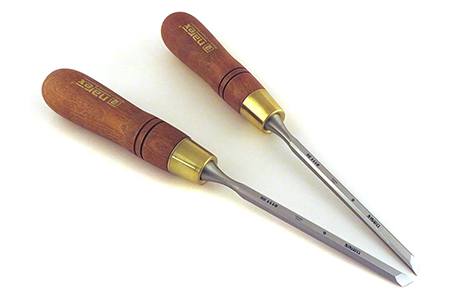
The skew types of chisels are comprised of a blade with an angled tip and a beveled blade. Woodworkers use them nearly daily due to their wide range of applications and their precision capabilities.
These include smoothing, tapering, beading, and creating v-shaped cuts or refining corners. The further most part of the tip is called the toe, which will shave the wood first, followed by the heel.
Masonry Chisel
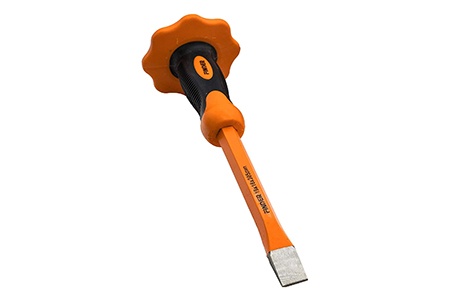
Sometimes you need to put in some serious work on bricks, stones, or mortar, and that's where the masonry chisel comes into play. They're constructed entirely of metal and tend to be fairly long. There's no tang or socket, just one solid hunk of metal.
The end will be capped off with a larger flat surface made to accept a mallet strike. The idea is to score lines along the sides of the parts you need to remove from the brick or stone, and then pop the rest out between in big chunks.
Sash Mortise Chisel
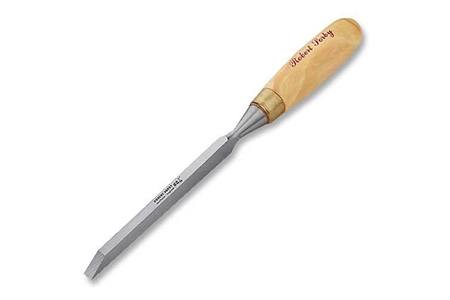
These are lighter mortising chisels and hence easier to handle. Sash mortise chisels were originally used to chop shallow mortises found in between the glass panels of wooden windows.
While they specialize in cutting shallow mortises, they work just fine for deep ones as well. These chisels can be used to drill out the waste in the process of mortising. But they have a thinner section compared to regular mortising chisels.
In the past, these chisels used to be sold in a variety of sizes but they were not bought by too many handymen and hence never became very popular. Today, it is mostly bought by those who want a versatile chisel set.
Cold Chisel
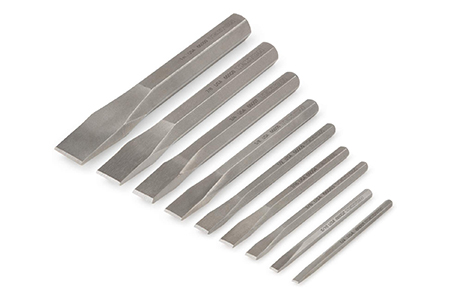
Cold chisels are one solid hunk of reinforced tempered steel. The reason it has the name it does is because it's meant for blacksmiths to cut metals after they've cooled rather than while they're hot right out of the forge.
Be careful because they're only meant to work on metals softer than itself, so take note of the material it's made out of. Like if you're removing some types of bolts they need to be made of a softer metal than the cold chisel itself or you'll damage the chisel and get nowhere.
Metalworkers reach for these types of chisels when they need to pop off rivets and nuts or removing stripped bolts when disassembling things.
Butt Chisel
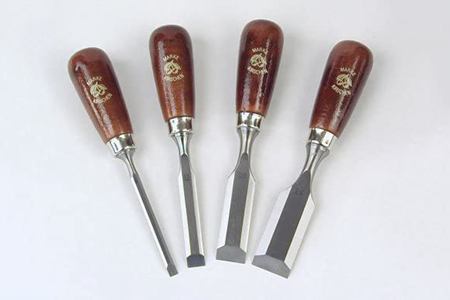
Butt chisels have the name they do because they're short in comparison to most others. Modifications to the bench and firmer chisel designs with both straight and beveled edges, they're shorter so they can fit in small places.
Specifically they're meant to install butts and door hinges. Carpenters were making their own short versions to the point where the demand increased that the actual product started being developed.
Concrete Chisel
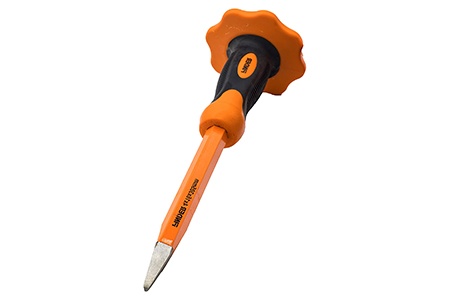
A concrete chisel doesn't look like others with flat edges. They have a pointed, spear-shaped tip instead. They aren't meant to shape, shave, cut, or add designs to concrete, either.
The goal with these is simply to apply a high pressure in a small amount of surface area in order to break concrete up so it can be removed and moved around. A jackhammer maybe too bulky for some jobs, and that's where these chisel types save the day.
Round Chisel
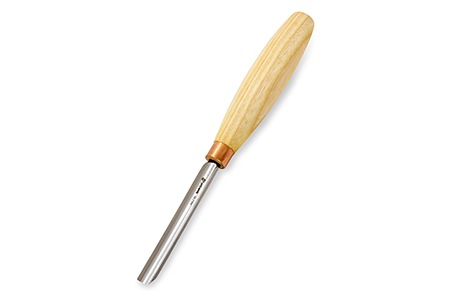
Round chisels are interesting. They terminate in a blade like all others but are tubular in shape with a circular blade. They exist to score channels into wood or metal surfaces. There's also half-rounded styles that achieve the same goal.
They're usually made of steel so they can work with both metal and wood, and like others you'll need a whole set to have access to different channel sizes, lengths, and hex key sizes.
Curved Chisel
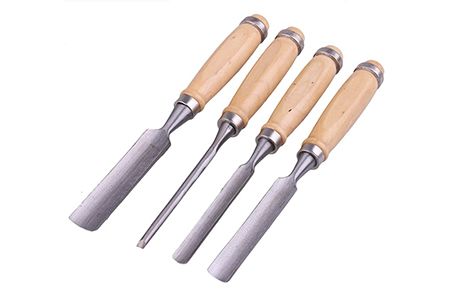
We've covered v-shaped chisels that cut 90 degree angles. These are similar but come with u-shape blades at the tip. You could consider them similar to round chisels.
They're also called gouge chisels. These come in all types of depths and degrees of roundness, so be prepared to expand your collection.
Heavy Duty Sash Mortise Chisel
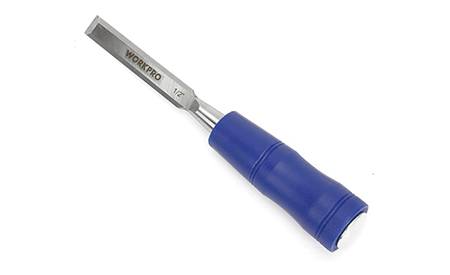
This next variety of chisels is a heavier version of the previous one, as the name indicates. They were originally developed in continental Europe and are more general purpose.
They have round handles and a square chisel section. That is why they are not very comfortable to use when compared to the English mortise chisels.
But because of these features, heavy-duty sash mortise chisels are relatively cheaper to make. Before the English mortise chisels were reintroduced, a lot of users found these to be extremely useful.
Electric Power Chisel
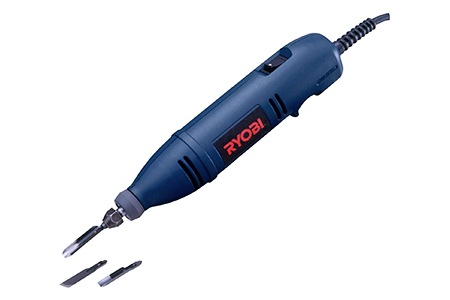
This shouldn't come as a surprise to you. Power chisel types are chisel attachments that can be socketed into an electric or battery powered handle that features a motor. You'll find them under the name of "electric carving knives" too.
The chisel blade will move back and forward rapidly to save you the trouble. Don't expect to do precision work though, like making a cutting board.
Dovetail Chisel
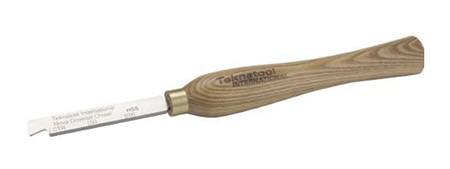
The name tells all you need to know about these different types of chisels and their uses. These are meant to help you cut dovetail joints, which need to be nearly perfect if visible so they look seamless and beautiful, which is the point of this type of handmade craftsmanship.
The blades will fall between a 20 to 30 degree angle, with a long blade or tang so you can reach into the joint. The blades are also kept thin for this same purpose. It's all about cutting out and then putting a fine finishing touch on the dovetails.
Cranked Handle Chisels
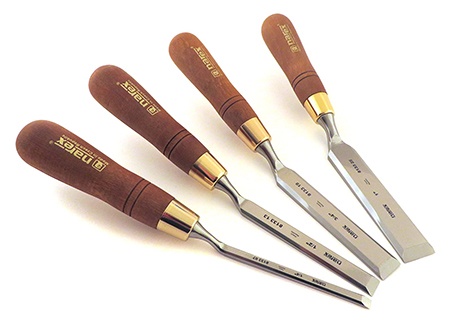
The name might confuse you. These chisel types aren't operated by crank, but the blades are "cranked" at an angle from the handle. They let you place the blade at a very acute angle to the wood and still tap the handle at a comfortable angle.
If you're creating very flush surfaces, especially in tight spots, and don't want to use a hand planer or any types of sanders, these are great. They come with very wide blades, thin ones, and everywhere in between.
Paring Chisel
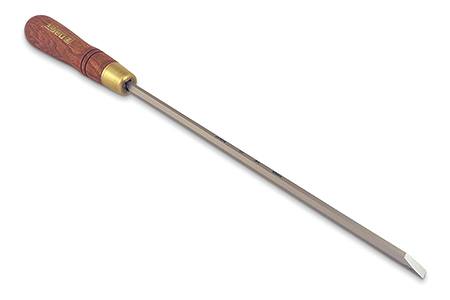
These chisels are lightweight, long, thin, and very sharp at the edge. They are very flexible and never used for malleting. Their primary purpose is to help with delicate work like shaving off a thin amount of wood when fitting joints. And it has to be done carefully.
Since they are long, they give the user the maximum amount of control. Place one hand on the handle and push it forward.
Place the other hand upfront on the blade and guide the cutting. The classic use of this chisel is to dress the sides of the mortise after chopping it square.
If you do a lot of joinery work, this is a good one to own. Their range is limited but their function is highly specialized.
Firmer Chisel

It is named firmer chisel because it is made of hard substances like solid steel. These chisels are used in heavy-duty woodwork like building a pallet adirondack chair. Their blades are made of a rectangular cross-section and the handles are made of hardwood.
This is one of the oldest types of chisels and is considered to be distinctive. If you are working on a project that requires you to make 90-degree corners, this is your tool.
Types of Chisels for Every Job & Material
The point here is that you need to identify the materials you will be working with and pick the right chisel types for the job. It's not just the materials but also whether or not you're doing specialized work, heavy-duty work, or detail-oriented work.
Once you've narrowed that down, it's not hard to find the different types of chisels you'll need. Over time you'll collect most of them and always have them on hand. But for now, one set at a time will do.



